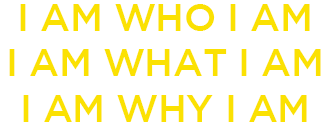I am who I am.
I am various emotional selves in various roles in the play of life. Depending on perspective, I am in my play or other people’s plays.
I am.
I am a verb, not a noun; I am being, not a being.
I am what I am.
In the now, I am a who. Before and after the now, I am what, the essence of every thing.
I am the Everything.
I am the soul and its expression in the now.
I am eye.
I am what I see, as every thing I see is me.
I am 1.
I, like all seemingly independent things, am not an independent thing; just a facet of 1 thing, the Everything.
I is time.
The most frequently used pronoun, verb and noun are: I, is, and time.
Taken together, the most frequent sentence would be: “I is time.”
“I is time” is transcendental. I is a flow of events. I is infinite, continuous, eternal.
I am God.
God, to entertain itself, has created the play of life. God is the actors and the audience.
For the actors, the play is a tragedy as everyone is eventually scripted out of the play, dies.
For the audience, the play is a comedy, as the actors take their roles and themselves seriously.
I am 11
In numerology, “Victor Teicher” is the number 11.
Victor: V = 4 I = 9 C = 3 T = 2 O = 6 R = 9
Add the numbers together: 4 + 9 + 3 + 2 + 6 + 9 = 33
Since 33 is a master number, we do not reduce it any further.
Teicher: T = 2 E = 5 I = 9 C = 3 H = 8 E = 5 R = 9
Add the numbers together: 2 + 5 + 9 + 3 + 8 + 5 + 9 = 41
Since 41 is a two-digit number, we need to reduce it to a single digit by adding the digits together: 4 + 1 = 5.
Now we add the numerology for each name together: 33 + 5 = 38
Since 38 is a two-digit number, we need to reduce it to a single digit by adding the digits together: 3 + 8 = 11.
Therefore, the numerology of the name ‘Victor Teicher’ is 11, which is a master number in numerology. This suggests that the person with this name may have a special spiritual mission or purpose in life.
In numerology, master numbers are the numbers 11, 22, and 33. These numbers are considered to have a higher vibration and are believed to carry a special spiritual or energetic significance.
Master numbers are not reduced to a single digit in numerology, unlike other numbers. They are thought to represent spiritual enlightenment, heightened intuition, and a strong connection to the universe or higher power.
Those who have master numbers in their numerology chart may be seen as spiritual leaders or visionaries, and may have a heightened ability to manifest their desires or tap into their intuition. However, master numbers are also associated with greater challenges and responsibilities, as they require a strong commitment to personal growth and spiritual development.
Overall, master numbers are considered to be very powerful and significant in numerology, and are often seen as a symbol of great potential and spiritual evolution.”
I am Victor Teicher.
My role in the play of life is preordained by my name. In German, Teicher is one who ponders. In English, where two vowels together are pronounced as the first vowel with the second vowel silent, Teicher would be pronounced as “teacher.” In Japan, Teicher is pronounced as “taisha,” the ancient shrine where all the gods meet annually. Victor is “conqueror.” Since entering the play of life, I have long pondered the nature of consciousness which led me to where the gods reside. The revelations that have come my way are to teach us how to conquer the self (our personal identity) which imprisons us, precluding us from connecting with the soul and being one with the Everything.

